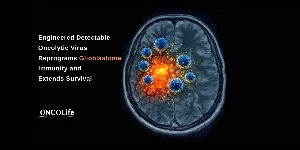Blenrep Combination Reduces Death Risk by 42% in Relapsed Multiple Myeloma

The DREAMM-7 trial shows belantamab mafodotin combined with bortezomib and dexamethasone significantly improves overall survival in relapsed or refractory multiple myeloma, reducing death risk by 42% compared to standard therapy. This combination also enhances MRD negativity, with manageable side effects.
GSK announced results from the Phase III DREAMM-7 trial at the 66th American Society of Hematology (ASH) Annual Meeting and Exposition, demonstrating that Blenrep (belantamab mafodotin) in combination with bortezomib and dexamethasone (BVd) significantly improved overall survival (OS) in relapsed or refractory multiple myeloma (RRMM) when compared to a standard-of-care regimen of daratumumab, bortezomib, and dexamethasone (DVd).
“The compelling overall survival data from the DREAMM-7 trial establish the potential of Blenrep in combination to significantly extend the lives of patients with multiple myeloma at or after first relapse. This represents an important advancement that could redefine the treatment of relapsed or refractory multiple myeloma,” said Hesham Abdullah, Senior Vice President, Global Head Oncology, R&D at GSK.
Key Findings from DREAMM-7
- Overall Survival: With a median follow-up of 39.4 months, BVd reduced the risk of death by 42% compared to DVd. The hazard ratio (HR) for OS was 0.58 (95% CI: 0.43-0.79; p=0.00023). Although neither arm had reached a median OS (mOS), the projected mOS was 84 months for BVd versus 51 months for DVd. At three years, 74% of patients in the BVd arm were alive, compared to 60% in the DVd arm. The survival benefit emerged as early as four months and persisted throughout the follow-up period.
- Minimal Residual Disease (MRD) Negativity: Beyond OS, the BVd combination demonstrated a statistically significant improvement in MRD negativity. Initially observed at the primary analysis, the greater than 2.5-fold improvement in MRD negativity became statistically significant (p<0.00001) following the positive OS results, reinforcing the combination’s potential to achieve deeper responses.
- Additional Endpoints: BVd produced clinically meaningful improvements across all key secondary efficacy endpoints. Notably, there were enhancements in duration of response (DOR) and progression-free survival 2 (PFS2), indicating both higher quality and longevity of disease control.
Clinical Context and Supporting Evidence
The positive OS findings from DREAMM-7 build on the earlier progression-free survival (PFS) benefits reported in both the DREAMM-7 and DREAMM-8 trials, which investigated belantamab mafodotin-based regimens versus standard-of-care comparators. Combined, these results support the potential of Blenrep-containing combinations to become a new standard of care for patients at or after their first relapse of multiple myeloma.
Principal investigator Dr. María-Victoria Mateos, Professor of Medicine at the University of Salamanca, said: “The totality of evidence from DREAMM-7 represents a potential paradigm shift for multiple myeloma patients who have experienced a relapse or become refractory to initial treatment. The OS results shown with the belantamab mafodotin combination in DREAMM-7 further cement the potential of this regimen to prolong the lives of patients with relapsed or refractory multiple myeloma compared to a standard of care daratumumab combination.”
Safety Profile
The safety and tolerability of BVd were consistent with previous analyses and the known profiles of the individual agents. The most notable Grade ≥3 adverse events (AEs) of clinical interest included thrombocytopenia (56% for BVd vs 35% for DVd), anemia (9% vs 10%), and neutropenia (14% vs 10%). Eye-related AEs, a recognized adverse event associated with belantamab mafodotin, were typically manageable and resolved with appropriate dose modifications. Only 10% of patients discontinued treatment due to these events.
Based on results from DREAMM-7 and DREAMM-8, regulatory submissions for belantamab mafodotin combinations are under review in seven major markets, including the United States, European Union, Japan, China, the United Kingdom, Canada, and Switzerland.
About the DREAMM clinical development programme
The DREAMM (DRiving Excellence in Approaches to Multiple Myeloma) clinical development programme continues to evaluate the potential of belantamab mafodotin in early lines of treatment and in combination with novel therapies and standard of care treatments. In addition to DREAMM-7 and DREAMM-8, a phase III study in newly diagnosed transplant ineligible multiple myeloma, DREAMM-10, is expected to be initiated by the end of 2024. About DREAMM-7: The DREAMM-7 phase III clinical trial is a multicentre, open-label, randomised trial evaluating the efficacy and safety of belantamab mafodotin in combination with bortezomib plus dexamethasone (BVd) compared to a combination of daratumumab and bortezomib plus dexamethasone (DVd) in patients with relapsed/refractory multiple myeloma who previously were treated with at least one prior line of multiple myeloma therapy, with documented disease progression during or after their most recent therapy. A total of 494 participants were randomised at a 1:1 ratio to receive either BVd or DVd. Belantamab mafodotin was scheduled to be dosed at 2.5mg/kg intravenously every three weeks.











Comments
No Comments Yet!